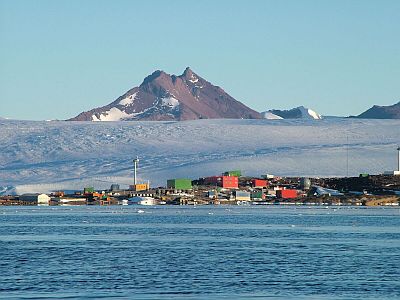Select units of measurement for the temperature and rainfall tables (metric or imperial).
Average weather, temperature, rainfall, sunshine hours
At the permanent Mawson base there is a
polar climate, with average temperatures below freezing almost all year round, except in summer, in December and January, when at least the maximum temperatures slightly exceed this value.
The base, founded in 1954, is the oldest of the Antarctic stations belonging to Australia. We are on the coast of Antarctica overlooking the Indian Ocean, at 67 degrees south latitude.
To the south of the station there is a mountain range, the
Framnes Mountains, which reach 1,490 meters (4,888 ft) above sea level. To the east, approximately 630 km (390 mi) away, is Davis Station.
We are on the edge of the East Antarctic plateau, where the coldest areas in the world are located.
The
katabatic winds blow from inland areas, and can sometimes reach hurricane force. Mawson is the windiest of the Australian Antarctic stations, and also of all the Australian-operated weather stations. The wind blows on average at 39 kph (24 mph), and gusts can exceed 250 kph (155 mph).
The frequent wind allows energy to be produced through
wind turbines.
The local
fauna includes species such as penguins, seals and elephant seals, as well as migratory birds.

In
winter, from May to September, the average
temperature ranges from -16.4 °C to -18.2 °C (-0.8 to 2.5 °F). We therefore have, as is typical of Antarctica, a "coreless winter" (from the German
Kernlose Winter), that is, one that lasts a few months, during which the average temperature does not vary much.
However, there are notable variations depending on the type of weather. In fact, sometimes the currents from the ocean prevail, and the temperature can approach freezing even in the coldest months (even though this value is generally not reached), while in other periods, the currents from the inland areas can bring
intense cold, down to -30 °C (-22 °F) or even below. The record is -36 °C (-32.8 °F), set in July 1979 and July 1985. After 2000, the record is -34 °C (-29 °F).
The sea on the coast freezes approximately from April to November.
In
summer, temperatures are more stable, however, on milder periods the they can reach or exceed 6/7 °C (43/45 °F). The record heat is 10.6 °C (51 °F), set in January 1974 (when records were also broken in other areas of Antarctica, such as in one of the other Australian stations, Davis, but also in the McMurdo dry valleys).
Here are the average temperatures.
Mawson - Average temperatures (1991-2020) |
| Month | Min | Max | Mean |
|---|
| January | -3.4 | 2.4 | -0.5 |
|---|
| February | -7.7 | -1.2 | -4.4 |
|---|
| March | -13.8 | -7 | -10.4 |
|---|
| April | -18.2 | -11.6 | -14.9 |
|---|
| May | -20.7 | -13.2 | -17 |
|---|
| June | -20 | -12.8 | -16.4 |
|---|
| July | -21.5 | -14.1 | -17.8 |
|---|
| August | -21.9 | -14.6 | -18.2 |
|---|
| September | -21.1 | -13.9 | -17.5 |
|---|
| October | -17 | -9.7 | -13.4 |
|---|
| November | -9.2 | -2.4 | -5.8 |
|---|
| December | -3.9 | 1.9 | -1 |
|---|
| Year | -14.9 | -8 | -11.45 |
|---|
Due to the strong wind, which carries away the snow, at the Mawson station they give up measuring
precipitation, however it is estimated that it ranges from 200 to 300 millimeters (8 to 12 inches) per year.
The
atmospheric pressure is very low, 987 hPa on average.
Sunshine at Mawson Station is moderate, amounting to 1,837 hours per year. The sunniest period is from November to February, also due to the length of the days.
Here are the average sunshine hours per day.
Mawson - Sunshine hours| Month | Average | Total |
|---|
| January | 8.5 | 255 |
|---|
| February | 8 | 220 |
|---|
| March | 5.5 | 165 |
|---|
| April | 4 | 115 |
|---|
| May | 1.5 | 50 |
|---|
| June | 0 | 0 |
|---|
| July | 0.5 | 20 |
|---|
| August | 3 | 95 |
|---|
| September | 5 | 150 |
|---|
| October | 7.5 | 235 |
|---|
| November | 8.5 | 260 |
|---|
| December | 9 | 275 |
|---|
| Year | 5 | 1840 |
|---|
Since it is located, albeit slightly, south of the polar circle, Mawson station experiences the
polar night from 13 to 28 June. However, around midday, for a few hours, the sun approaches the horizon, resulting in some twilight.
On the other hand, in summer the
polar day occurs, in which the sun never sets, from November 30th to January 13th. For a few weeks, before and after this period, the sun remains close to the horizon even at midnight, providing some light, so the so-called "white nights" occur.
At the summer solstice, December 21st or 22nd, at midday the sun reaches 46 degrees above the horizon, more or less double that at the South Pole.